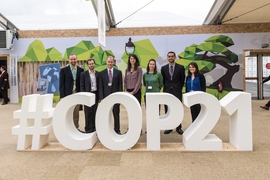On one of the coldest days in January, a group of MIT students and staff boarded a bus to the small peninsula town of Hull, Massachusetts, for an MIT Energy Initiative (MITEI) wind turbine tour during the Institute’s Independent Activities Period (IAP).
Tour leader Andrew Stern, president of New England Wind Power, greeted them, as did a winter sea breeze that was strong enough to knock off several people’s hats. Stern and Pat Cannon, chair of the Hull Municipal Light Board, ushered people inside the wind turbine. Everyone — a group of about 20 — was able to fit in the cylindrical base of the tower comfortably, relieved to be temporarily sheltered from the wind that makes this location such a good site for a turbine. Once inside, Cannon gave the group an overview of the turbine’s structure and electric generating capacity. Faces turned upwards as he spoke, taking in the sheer size of the structure.
Hull Wind 1— 150 feet tall with a 0.66-megawatt generating capacity — is the first of two wind turbines currently providing power to the town, and was built in 2001 to replace an outdated, poorly maintained turbine that stood in nearly the same place. Hull Wind 2 was installed in 2006 in a different part of town. Together, the two turbines generate 10 percent of energy needs for the town of Hull: the equivalent of 1,100 homes and all of the traffic lights. A minimum wind speed of 7 miles per hour is required to start the turbine moving, and as the group saw firsthand, the turbines automatically shut off when wind speeds reach about 50 mph.
Paul Cohen, an MIT exchange student whose enthusiasm for the trip was visible, shared his passion for wind energy throughout the day. “I came on this tour because I quite like wind turbines. I’m a mechanical engineer and I’ve come to be quite interested in the technology,” he said.
Another student, Melody Chang, was also interested in the business side of the turbine: “I’m curious about what the main concern is that people have about putting wind turbines in their communities”.
“I wanted to look at wind turbines and see how they worked and hear from people who actually decided to make the investment,” added Raina Gandhi, a research assistant at MITEI working on energy efficiency programs.
The program drew many students from all different academic backgrounds, each highly engaged in the tour, from business students to engineers. That’s the beauty of IAP: Everyone is drawn to the activity for different reasons, but leaves with a taste of the other participants’ interests as well, which can spark new ideas for future areas of study or extracurricular activities.
Rebecca Eisenach has only recently started her studies as an engineer at MIT, but she already has a solid desire to go into renewable energy: “My dad is actually in the wind energy business, so it’s kind of a family thing,” she said. She is considering enrolling in the popular energy studies minor in the near future.
MITEI has sponsored three IAP programs during the 2016 period; the trip to the Hull wind turbine, an “Energy of Transportation” tour of several Massachusetts Bay Transit Authority facilities, and Undergraduate Research Opportunities Program information sessions.
Sara Gallegos, student engagement coordinator at MITEI, thinks the hands-on learning IAP encourages is an essential part of the MIT experience. She said, “Part of MITEI’s mission is to foster opportunities for energy education. By taking students on a wind turbine tour during the Independent Activities Period, we’re helping them to see energy in action.”









